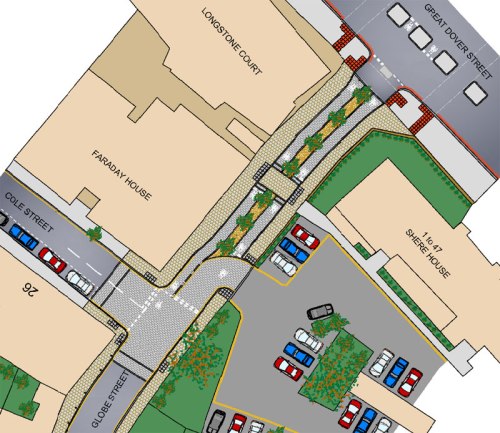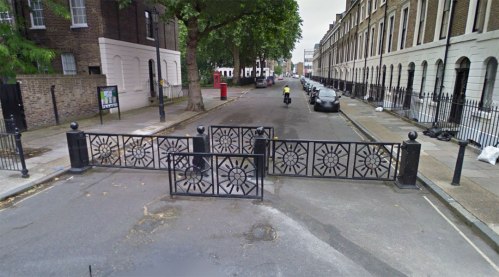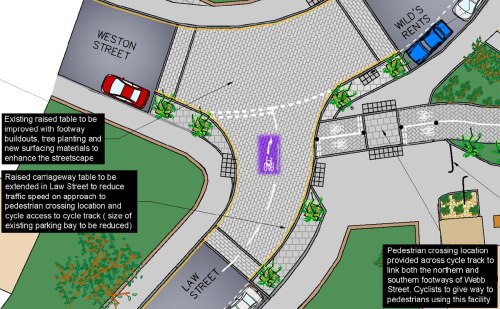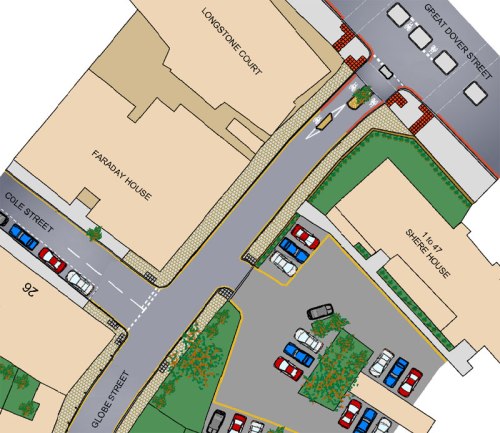So the plans for Andrew Gilligan’s much-discussed “Quietways” are starting to appear.
Here I’ll look at the plans for the part of the route with which I’m very familiar, east of Waterloo in central London. (If you have knowledge of the route beyond Law Street, please do let me know your thoughts in the comments. The Kennington People on Bikes blog has covered more of the route here though I must say that the suggested changes are rather milder than I’d want to see.)
I’ll say now that I’m not impressed by these plans. They seem to consist of nothing but signs on a route which is already fairly quiet, although not quiet enough in my experience, as much of it needs modal filtering to prevent motor vehicles using it as a through-route.
But these weak plans seek to solve none of the problems that exist along the route, they are mostly just window dressing of the existing infrastructure.
Assault-course cycling
For example, the planned changes on Globe Street offer nothing new for those cycling – quite the opposite in fact, as they introduce four new points at which people riding bikes must give way, while providing no benefits over the existing arrangement.
Here’s Globe Street as it is today:
It works pretty well already (despite the incorrect signage, and even with a lorry parked on the street).
The junction mouths could be wider to allow cycling two-abreast, and there’s a superfluous island (I assume it’s left over from before 2010 when the street was one-way for motor traffic with two-way cycling, before the junction became bikes-only, hence the now-oddly-positioned arrow), but it does work fine. In fact Pilgrimage Street, on the other side of Great Dover Street, ideally needs the same bikes-only junction treatment.
Now here’s the new Quietway plan for Globe Street:

Southwark’s over-engineered plans are a waste of money and energy, and offer no improvement over the current layout.
My question is: how does this make cycling easier or safer?
It feels like a desperate attempt to spend the Quietways money somewhere – anywhere! – rather than admit that the plans are nothing but some signs and paint and spend the money on something useful.
Cycling north-east, one will enter a narrow channel, then mount a hump up to footway level, before dropping back down and reaching the junction. As the foot crossing leads to a locked back gate, I’m not convinced of the need for it. (Perhaps Southwark Council really do expect higher foot traffic than pedal traffic here…)
Don’t get me wrong, if foot traffic is high then we should consider giving it priority over other modes. This is a design I’d love to see on some of London’s other, car-filled roads, by the way. But that wouldn’t ever be considered – it’s only where bikes are concerned that we can tame the roads, it seems.
Cycling in the other direction, THREE new give-way points for people on bikes are to be installed. The first is just before the raised pedestrian crossing, the second is just before the car park exit, and the third is just after the car park exit. I have absolutely no idea what the third give-way is for, other than to punish people for riding a bike.
Why is there even an entrance/exit to the car park on Globe Street? There’s another one to the south side of the car park, surely that’s enough capacity for one apartment block. (Blocking off the exit to Globe Street would mean there’s capacity for a few more car parking spaces for residents, too – win-win!)
No wheelchairs or trikes, please – we’re British highways engineers
After negotiating all that, there’s a fourth give-way to a dead-end carrying no motor traffic at all. Why the priority can’t be changed in favour of bikes on the Quietway, I have no idea. The number of other vehicles using that part of Trinity Street must be almost zero.
Talking of Trinity Street, there’s this lovely bit of ironwork:

Yes, you are actually meant to cycle through this. (Photo: Google Maps)
This particular test of stunt-bike skills is designed to stop people using the street as a rat-run by motorbike – and kudos to the residents for preferring to have a quiet street instead of the dubious pleasure of being able to drive out of it at both ends (unlike the residents of Gilbert Road in Cambridge who value saving a few minutes’ driving over clean air, quiet roads, and safety).
But surely there are better ways of preventing rat-running by people on motorbikes without reducing the cycling capacity to almost zero? And it does massively restrict cycling capacity, as it takes so long to negotiate safely. Many mount the footway to get by, though my favoured solution was simply to use the parallel Cole Street, which features no such restriction. This isn’t designing for mass cycling, it’s a bad joke.
I’m not even sure that the anti-(motor)bike fence is needed any more anyway, as Trinity Street’s junction with Great Dover Street has been blocked off now. It would be simple to extend the new plaza to separate Trinity Street from Falmouth Road, meaning that Trinity Street would be a dead end and of no use to rat-runners.
However, the only planned improvement to this ridiculous bottleneck is to move the two central fences away from the gap, by 30cm, “to comply [with] current cycling design guidelines and ensure cyclists of all abilities can negotiate this feature”. This is paying lip service to the concept of cycling infrastructure which is suitable for all ability levels – no such worries seem to have occurred to the designers elsewhere on this route.
Lipstick on a rat-run
Webber Street, Great Suffolk Street and Law Street are all currently used as rat-runs by people driving motor vehicles, and under these plans they are to remain so. This is not designing for all abilities.

The Google Streetview camera catches a typical scene at the junction of Webber Street and Great Suffolk Street.
There are only superficial changes planned at this junction, so the scene above will continue to occur. What if the lights turn green just as you start to pull out, do you trust the drivers not to move forward? Can you see if there are more bikes coming from the left, hidden behind the van? Can you imagine members of your family making this manoeuvre?
A few bollards and entry restrictions would fix this in no time, making the junction bikes-only by blocking off the end of Webber Street as well as Great Suffolk Street to the west. So why are no such improvements included here? They genuinely would improve the roads for people cycling, while keeping access for residents and businesses, and would cost very little too.
Law Street has the same problem. It should be a quiet residential street, but stand there at rush hour and you’ll see it’s mainly used as a speedy short-cut by people driving cars. If a cycle route isn’t suitable 24/7, then it’s not a cycle route.

I’ve highlighted the Quietway right turn in a lovely shade of official Quietway purple. Can you imagine a young child waiting there while cars were passing around them on all sides?
Put some bollards on the junction at the end of Law Street and the problem is solved. The right turn along the Quietway can then be made safely, rather than waiting in the centre of a maelstrom of taxis.
Two other points about Law Street: Firstly, you’ll see a pedestrian-priority crossing of the cycleway at the end of Law Street. Why isn’t the same pedestrian priority being installed on the carriageway?
The truth is that motor vehicles are far more dangerous than bikes, so people on foot need more help to walk where there are motor vehicles than where there are bikes. And yet I keep seeing designs that suggest the opposite, that the very concept of a bike is toxic and lethal while all cars are made of marshmallow and driven by kindly vicars.
Secondly, the “bikes right turn” painted symbol could lead drivers to believe that all bikes indicating right are turning onto the Quietway cycleway, whereas some will be turning onto Wild’s Rents instead, potentially leading to dangerous under-taking on the junction.
Protected cycleways where they’re not needed
The plans for Tabard Street are over-engineered, with a short length of unnecessary cycleway that looks too narrow, and bike symbols painted in the door zone of parked cars (this particular intervention seems to feature throughout the plans).
Regular readers will know that I’m an advocate of high-quality physically separated cycleways, but this ain’t it. We need them on busy main roads, not on quiet back streets! I thought the whole point of the Quietways project was to use cheap measures to reduce motor traffic on a string of roads to form a safe cycling route. So I don’t understand the need for the pointless cycleway here.
Tabard Street is long and straight and vehicles drive too fast along it (hence the speed humps). Why not simply block it off to motor vehicles at the Quietway’s entry and exit points, thereby removing through-motor-traffic while preserving access for residents? (That way, we won’t even need the bike symbols painted in the parked car door-zone, either.)
Money to spend on whatever
Furthermore, I’m concerned that footway and general carriageway improvements appear on the plans. I’m all for improving the footway but surely this should not come out of the cycling budget (especially removing old, redundant driveway drop-downs as seen here on the ‘plan I’ PDF, surely property developers should pay for this when they remove the garage or driveway?).
And what to make of the fact that in only 2.4 miles, there are apparently a grand total of 41 humps along the length of Quietway 2 in Southwark?
I get the impression that the scheme has some money behind it that must be spent, but as the designers are unwilling to add filtering to remove routes for motor vehicles, they don’t know where to spend it. Hence the ridiculous over-engineered stuff on Globe Street and Tabard Street.
I’m still not convinced that the Quietways concept is even a good one. It seems to be a continuation of the failed dual network approach, where some people are expected to put up with inconvenience while others put up with danger.
Who are these people who currently won’t cycle, but will happily leap onto a bike once Andrew Gilligan installs some signs along an already existing, convoluted, twisty-turny route full of humps and rat-running drivers, where they have to constantly give way to everyone? I’m not sure that these people exist.
The whole idea seems to be designed to shut cycle campaigners up while not upsetting the all-important drivers by making any actual changes to the roads. The Quietways don’t seem to form a network, and they’re definitely not the fine grid of interconnected cycling-friendly routes which are needed to enable mass cycling.
It feels a lot like we’re repeating the mistakes of the recent past by creating yet another version of the failed London Cycling Network, with isolated scraps of strange infrastructure, fading paint, and neglected signs scattered around the city.
It doesn’t even live up to its branding, as many of the roads that should be “quiet ways” are, in reality, speedy rat-runs which are to remain exactly as they are.
If you’re minded to take part in the consultation – and given the result of recent consultations I’m not sure it’s worth the bother – then you can submit comments via Southwark Council’s website here.



 The Alternative Department for Transport is written by, and the personal opinion of,
The Alternative Department for Transport is written by, and the personal opinion of, 



I have been looking at some Quietways on my patch and have told TfL that unless they prioritise and protect cycling, then there is little point, despite them being quite direct. We have places where we need cycle traffic signal stages and new bridges which is more than paint’n’signs.
That Southwark scheme looks like the wrong approach and I trust Gilligan will reject it. Send objections to him!
I hope this scheme will be kicked into touch. All this route really needs are some bollards and entry restrictions to keep the rat-running through-traffic off it.
Genuine question: all these narrow gate restrictions, designed to keep out motorbikes – are motorbikes a genuine source of danger in places like that, or is it a case of another out-group who must be punished?
Oh, and you know the highway engineers thing isn’t aimed at you 😉
Your header “We are highways engineers” as an aggressive stance is a pity. Its a pity there is no reference to cycling in it, which usually includes
by ways too. Absolutely excluding wheelchairs and trikes, self propelled, is mistaken, though petty. What other term can be applied ?
“Cycleway engineers” would be fine as a sub class of highways engineers.
You’re a bit like a church mouse saying he is god. Why bother? You’ve got different runs.
I’m sorry, you’ll have to rephrase that, I have no idea what you’re saying.
Yup, totally lost me too.
I think Gareth may be a spam-bot. For what purpose, I have no idea.
Oh that does look bad. Just as well they don’t expect many people use it…
It may sound flippant, but that’s the truth isn’t it ?
We know that poor infrastructure doesn’t attract people. Making journeys take longer than they should certainly isn’t a characteristic of cycling infrastructure which convinced people to cycle. Routes which don’t go near many peoples’ destinations also aren’t a great attractor. What people need is good old-fashioned go-everywhere convenience.
We wait quite some time between each drip from the slow trickle of poor proposals coming from London, each of which seems to be accompanied by fabulous press-releases which reach right around the world. The whole thing adds up to a lack of real ambition for cycling to become a mass means of transport in London, though they’d clearly like to create the impression of progress.
Thirty years ago I played an adventure game which would quite often print out the message “You wait – time passes”. That was thirty years ago. Has much changed ?
Nearly another six months have passed since I wrote of how a whole year had passed since London was 40 years behind…
I think that really is the truth – they are genuinely planning for low numbers of users. There’s no way it would be designed like this if they were expecting a big rise in bike use.
London really is great at hype, and the illusion of progress. The section of these plans I’ve looked at offer no actual progress whatsoever – there’s nothing at all that would make me more likely to use a bike along there, there’s no actual improvements to the journey whatsoever.
By the way, I guessed the game before clicking on the link! 🙂
Interestingly, I started at the other end of the plans and stopped at the same point. My impression could not have been more different. I cycle along the Oxleas Road – Rossetti Road section (the estate on the old Bricklayers Arms goods yard) most days and Southwark’s plans remove most of the annoyances and even include some nice innovations (anti-motorcycle humps! http://www.aviewfromthecyclepath.com/2011/11/speedbumps-on-cycle-path.html).
That said, the Eastern half of the route is on much quieter streets, many already closed to through traffic. It is a shame Southwark don’t seem willing to take cycling seriously in busier areas. As you say, LCN by another name.
Anti-motorcycle bumps in the Netherlands are not exactly common. We manage to see two pairs on the last day of the the study tour. This requires going on a bit of a detour.
In the entire seven years that we’ve lived in the Netherlands I don’t think I’ve come across so many bumps as the 41 in just 2.4 miles which are proposed here.
This is one of those “lost in translation” issues. Yes, bumps to slow motorcycles are quite a good idea, and they’re effective. But… they need to be very well engineered and they need to be rare. On the first point, we don’t know yet about London’s plans, but on the second point they’ve failed already.
Still… I of course hope your optimistic takes turns out to be accurate. London certainly needs better infrastructure.
I always followed Wild’s Rents up from there, so didn’t want to cover areas I didn’t know. (I only used Law Street very occasionally, as it was so rat-runny, I preferred to go through the park instead.)
I’m glad to hear that the route east of there is better. I guess I’d rather have humps than gates, providing they’re done right. (I’ve had a blog post in draft for ages about getting humps right. In the UK they very rarely meet the DfT’s specification for a sinusoidal shape, and usually end up horrible to cycle over.)
I’m tempted to do Southwark’s work for them, and show how they could get a better result for less money. Seems like what they’re doing on this section is spending money for no result – that’s not good value!
As an aside, I understand Lewisham reckon it will take them until late 2016 to sort out their end.
Did somebody say “progress”?
Pingback: How Southwark can spend less to do more on their Quietway | The Alternative Department for Transport
Yeah, obviously the designers team should have cyclists among them to bring these projects down to earth. This stuff looks like an exercise in playing with drawings without any real understanding of the users’ viewpoint.
Where has the old wisdom of “keep it simple” gone?
Or maybe some secret sinister plot to discourage cycling is at work?
This area should be traffic calmed anyway. Closing off most minor side accesses, adding a 20 mph speed limit if it is not already happening, more filtered permeability to prevent rat running, making parking into dedicated bays, raising them about halfway between footway and roadway, paved in cobbles or black bricks, raised intersections, taking away all indications of who goes first so negotiation is required, paving the roadway in red bricks. They all make the minor residential streets work well. What a quietway would be would be if you had a cycle route through one of these quiet roads. It would be paved in red asphalt, following any curves, it would assign priority to the quietway as opposed to negotiation, it might also add more volume control if this is needed, and it adds wayfinding signage. It is not a replacement to the cycleways next to main roads where a cycle track is needed. It would also be a good idea to ban vehicles heavier than 3.5 metric tonnes and any vehicles longer than 9 metres in length from these roads as well, residential and main cycle route. Like this example from Den Bosch: https://bicycledutch.wordpress.com/2014/07/24/missing-link-completed/